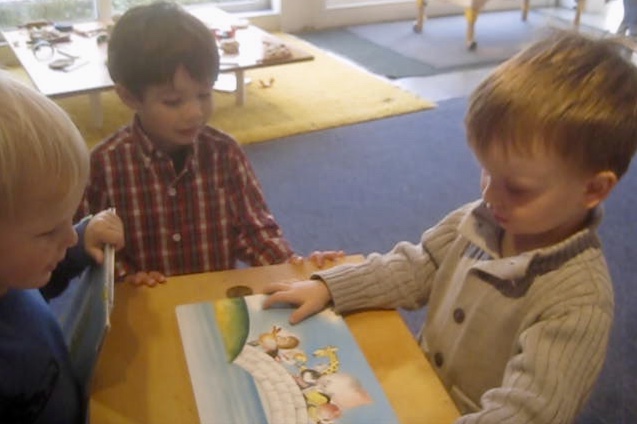Remember the earlier post showing
Wesley making a felt bridge?
He repeated this the following week,
and began one this week as well.

…Diane is curious about how children might respond to Brick by Brick (by Giuliano Ferri). When Johann, Wesley and Kesler arrive at this page…

Jack and Livia also show an interest in the book.
Livia notices the shape of the bridge,
saying that it is a rainbow that is also a bridge.


Considering this and the bridge Johann had constructed in the playdough area…

…Wesley exclaims: They’re building a bridge! Johann begins flipping backwards through the pages and Kesler notices The bridge broke. Johann counters It didn’t break, and explains: I just turned the pages.

When curved shapes appear in our playdough area, Livia notes that they, too, serve as both bridges and rainbows. She proceeds to cover one with playdough – she is putting a pool on top of a rainbow. When it is completely covered, she holds it up proudly: Ta da! Try to find my rainbow.
Bridges are also a logical extension of the fascination with things hidden and revealed – going across a bridge, you are seen; going under it, you’re hidden. So it’s delightful to see Livia transition from making her hidden rainbow bridge to hiding playfully under the table and then popping up to surprise Kesler, sometimes making silly faces at him. Soon he joins in the game!



Stella makes a bridge at the table, too, explaining that water is running under it.
On Thursday, we set out playdough and Kapla blocks on a small table. When children seat themselves here, we explain how Johann and Kesler had built bridges, while not dictating this activity.
Many children are interested, and try it out…
Stella creates the structure below, and later, Ellie, Josie and Stella enjoy an extended dramatic play making food for each other.
It’s not a big leap to connect the children’s interest in building long bridges with their penchant for lining up materials. Elliot and Jamie build this on the playground, then cross over it again and again (a structure that could certainly be construed as a bridge!).
After Wesley lines up chairs (in background), Jamie lines up the pink people.
Lining up can be horizontal…




